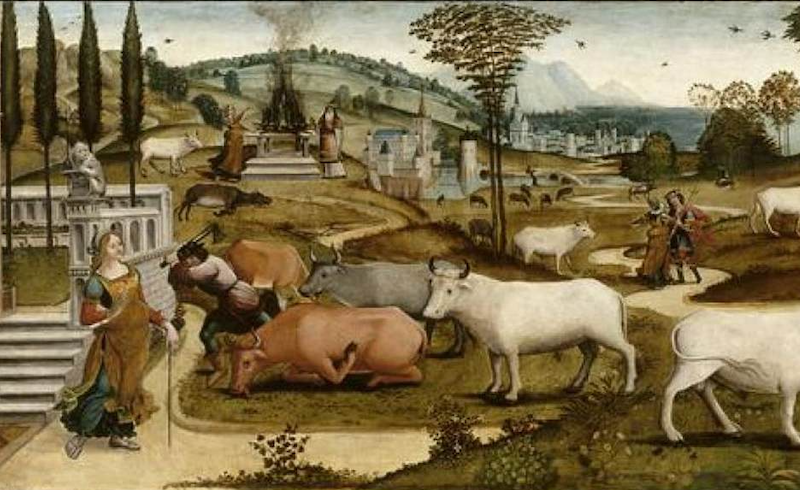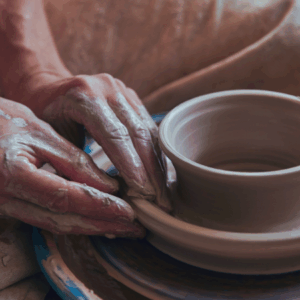One figure is female, the other is male.
Both are contained.
One figure is mythical, the other historical.
They occupy different millennia, different continents.
But both figures are considered Asian—one from Colchis, one from Korea.
To mention the Asianness of the figures creates a “racial marker” in the poem.
This means that the poem can no longer pass as a White poem, that different people can be expected to read the poem, that they can be expected to read the poem in different ways.
To mention the Asianness of the figures is also to mention, by implication, the Asianness of the poet.
Revealing a racial marker in a poem is like revealing a gun in a story or like revealing a nipple in a dance.
After such a revelation, the poem is about race, the story is about the gun, the dance is about the body of the dancer—it is no longer considered a dance at all and is subject to regulation.
Topics that have this gravitational quality of aboutness are known as “hot button” topics, such as race, violence, or sex.
“Hot button” is a marketing term, popularized by Walter Kiechel III, in a September 1978 issue of Fortune magazine.
The term suggests laboratory animals and refers to consumer desires that need to be slaked.
The term “hot button” implies not only the slaking of such desires but also a shock or punishment for having acted on those desires, a deterrent to further actions pursuing such desires, and by extension, a deterrent to desire itself.
Violence and sex are examples of desires and can be slaked, punished, and deterred.
Race is not usually considered an example of desire.
Both the female and the male figures are able to articulate their desires with an unusual degree of candor and specificity.
Both are responsible for many sexual deaths.
The male figure says, “When anger grips me, I cannot contain myself. Only after I kill something—a person, perhaps an animal, even a chicken—can I calm down. . . . I am sad that Your Majesty does not love me and terrified when you criticize me. All this turns to anger.” “Your Majesty,” here, refers to the king his father.
The female figure is never directly quoted, but Pseudo-Apollodorus writes that she casts a spell upon the king her husband so that when he has sex with another woman, he ejaculates wild creatures into the woman’s vagina, thereby killing her. Although the punishment is enacted on the body of the woman, this punishment is meant to deter the king from slaking his desires.
Both figures are figures of excessive desire, requiring containment.
Both containers are wooden.
Both containers are camouflaged with a soft, yielding substance—one with grass, one with fur.
Both containers are ingenious solutions to seemingly intractable problems.
One problem is political. One problem is sexual.
They are both the same problem.
They have the same solution.
The male figure waits in the container for death to come. He waits for eight days. His son will live. This ensures the succession, the frictionless transfer of power.
The female figure waits in the container for the generation of a life. We do not know how long she waits. Her son will die, after waiting in his own wooden container. This ensures the succession, the frictionless transfer of power.
There are many artistic representations of both containers.
The male figure’s container is blockish, unadorned, a household object of standard size and quotidian function. Tourists climb into it and pose for photos, post them online. The cramped position of their bodies generates a combination of horror and glee. This, in turn, creates discomfort, the recognition that horror and glee should not be combined, that such a combination is taboo.
The female figure’s container is customized, lushly contoured. Its contours are excessively articulated to the same degree that her desire is excessively articulated. Artists depict the container in cutaway view, revealing the female figure within, awaiting the wild creature. The abject position of the female figure—on all fours, pressing her genitalia back against the hollow cow’s genitalia—generates a combination of lust and revenge. This, in turn, creates discomfort—the recognition that lust and revenge should not be combined, that wild creatures and female figures should not be combined, that these combinations are taboo.
The tourist can climb into the rice chest. The tourist can pose for a photo in the rice chest. Then the tourist can climb out of the rice chest and walk away.
The artist can look into the hollow cow. The artist can render the contours of the hollow cow, the contours of the female figure. Then the artist can walk away.
Both containers allow the tourist and artist to touch the hot button, the taboo.
The desire and the discomfort remain contained.
Both containers allow the tourist and the artist to walk away.
The male and female figures remain contained.
Neither container—the rice chest, the hollow cow—appears to have any necessary connection to race.
To mention race where it is not necessary to mention race is taboo.
I have not mentioned the race of the tourist or the artist.
The tourist and the artist are allowed to pass for White.
The tourist and the artist are not contained.
I have already mentioned the race of the poet.
But to the extent that the poet is not contained, the poet is allowed to pass for White.
I have already mentioned the race of the male and female figures.
The male and female figures are contained.
The rice chest and the hollow cow are containers.
The rice chest and the hollow cow are not the only containers in this poem.
Colchis and Korea are containers in this poem.
Asianness is a container in this poem.
Race is a container in this poem.
Each of these containers contains desire and its satisfaction.
Each of these containers contains discomfort and deterrence.
Each of these containers contains a hot button, a taboo.
The tourist and the artist can enter each of these containers.
The tourist and the artist can touch the hot button and walk away.
Each of these containers separates the slaking of desire from the punishment of desire.
Each of these containers is an ingenious solution to a seemingly intractable problem.
They are the same problem.
They have the same solution.
Each of these containers ensures the frictionless transfer of power.
Each of these containers holds a male or female figure.
The name of the male figure can be translated as “Think of me in sadness.”
The name of the female figure can be translated as “I shine for all of you.”
____________________________

Excerpted from From From by Monica Youn. Used with permission of the publisher, Graywolf Press. Copyright 2023 by Monica Youn.
Monica Youn
Monica Youn is the author of four books of poetry, Blackacre, Ignatz, and Barter and most recently, From From. She has been awarded the Levinson Prize, the William Carlos Williams Prize, a Guggenheim Fellowship, a Witter Bytter Fellowship, and a Stegner Fellowship, and she has been a finalist for the National Book Award, The National Book Critics Circle Award, and the Kingsley Tufts Award. The daughter of Korean immigrants, and a member of the Racial Imaginary Institute, she teaches at Princeton and in the MFA programs at NYU and Columbia. She was formerly senior counsel at the Brennan Center for Justice.













